
'Winter On Fire: Ukraine's Fight for Freedom' and the representation of political discourse through truth and fiction
Winter On Fire: Ukraine’s Fight for Freedom is a documentary that depicts civil protests taken place in Kyiv in 2013-2014. The Oscar-nominated film was first released on September 3rd, 2015 during the Venice Film Festival. The documentary is directed by Evgeny Afineevsky. 'Winter On Fire' shows the path from the students’ pro-EU protests growing into the Revolution of Dignity full of violent action and callings for the resignation of the former Ukrainian president Viktor Yanukovych.
The viewer is taken on board from the very first days of the civil action. Slowly, the audience gets to know more about the chronological order and the historical context of the events. The viewer witnesses building up the tension in a society and experiences the Ukrainian revolution in the way protesters did. The current paper is going to analyze how the documentary was filmed to reach the dramatic effect of the viewer’s participation. It will contain an introduction, a main body which will go in-depth with the theoretical concepts, and it will conclude with raising the question of the role of cinematic representation in reinforcing political discourse.
Political context
‘Winter On Fire’ follows the chronological order of the events unfolding in Kyiv, Ukraine starting from November 2013 until February 2014. The civil unrest was primarily caused by the former president of Ukraine Viktor Yanukovych refusing to sign a free trade agreement with the European Union and announcing the change of the country’s direction in cooperating closely with the Russian Federation.
The documentary begins by showing peaceful student protests for Eurointegration. Slowly, the film uncovers such critical issues as police violence, state brutality, murder, kidnapping, repression, and censorship. The audience sees the buildup of tension in society that,
"does not want to go back to the Soviet Union” (Afineevsky, 2015) and has to protect the independence of Ukraine and basic human rights in the country.
The film has an important mission of showing the events through the perspective of Euromaidan’s protesters. The civil unrest and revolution in Ukraine in 2013-2014 were accompanied by lots of misinformation and fake news, heavily harming the country's support from abroad. The false narratives were mostly spread by 'the Kremlin' (Albrecht, 2019) and needed a sufficient informational response. ‘Winter On Fire’ plays an important role in news wars on the political events of Ukraine depicting pro-Russian State’s violence in relation to its citizens.
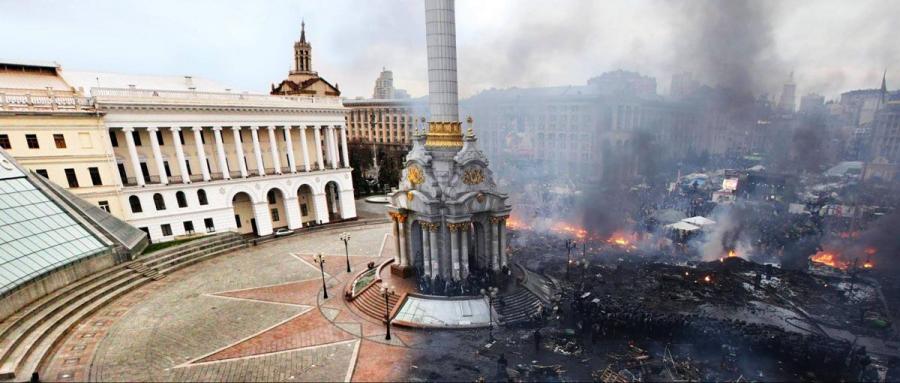
Kyiv's 'Maidan' before and after the events of 2013-2014.
Narrativity
The film barely makes jumps in time. ‘Winter On Fire’ starts with footage recorded on a mobile phone from the frontline battles with the special force police. This is done to capture the interest of the viewer and prepare the audience to observe the way the peaceful marches escalated into a violent revolution.
The documentary is highly precise and chronological in the unfolding of its events. The film tries to resemble the feeling with which people experienced the revolution by constructing a perfectly sequential narrative based on the collection of historical events. There is a popular belief about the nature of human experience being lived in the form of a constructed narrative (Strawson, 2004). By reconstructing the timeline, ‘Winter On Fire’ tries to capture the essence of the descriptive nature of human experience (Strawson, 2004).
The widespread agreement accepted in psychology, arts, philosophy, literary studies, medicine, and several other disciplines is that any event in human life unfolds as a narratively based story “or at least as a collection of stories” (Strawson, 2004). The documentary presents its stories in the manner of "this is how we are, it says, this is our nature" (Strawson, 2004). Reconstruction of the events in narrative form is an artistic tool used by 'Winter On Fire' to make the audience's experience of the movie as alike as possible to the real-life events. This narrational artistic strategy allows activation of the audience by appealing to their relatable empathy and emotions. Since humans live their lives as stories, it feels natural for them to relate to one.
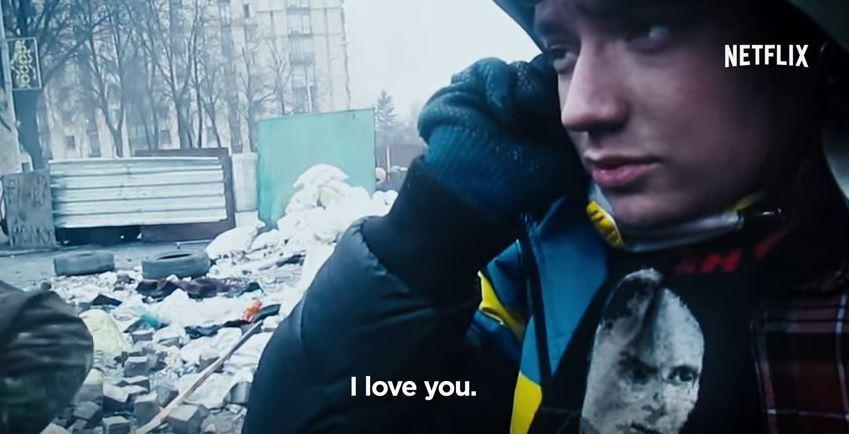
One of the protesters calling his mom to tell her he loves her from the frontline.
Strawson (2004) calls the feeling of humans living their lives like stories the psychological Narrativity thesis. What he means by that, and what we see in ‘Winter On Fire’ is the descriptive nature in which “ordinary human beings actually experience their lives” (Strawson, 2004). In the documentary, such an unfolding type is seen through two modes of representation.
The first way to apply the psychological Narrativity thesis is by looking at the documentary as a whole. Firstly, the film director Evgeny Afineevsky has tried to collect materials to help the audience follow the preexistent conditions of the protests. Secondly,the revolutionary movement itself, and finally concludes with the consequences of the civil unrest. Viewers witness the logically and historically constructed timeline which narrates the first mistakes made by the former politicians in power and explains why they fled as a result. ‘Winter On Fire’ follows the protesters moves as a resistance to the bloody totalitarian State that escalated in the years before 2014 in Ukraine.
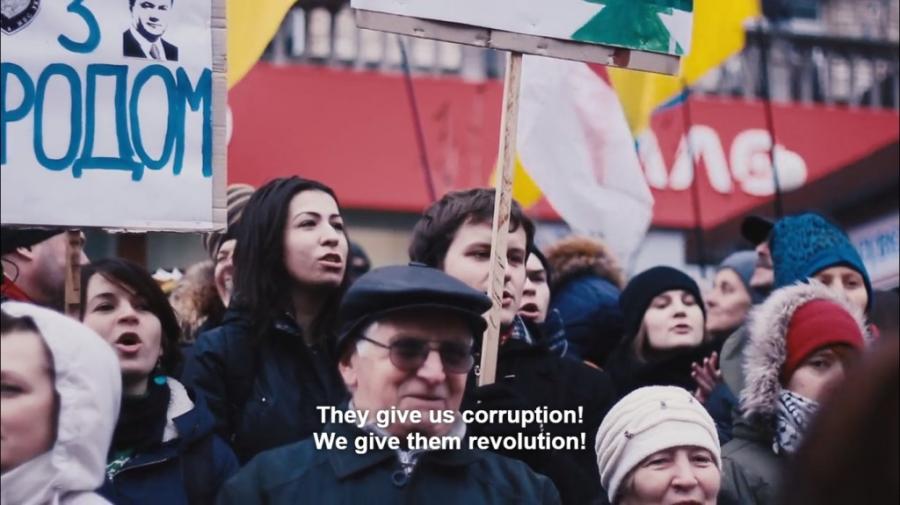
Footage from the first lines of protests in 'Winter On Fire'.
The documentary ends with mentioning that deaths and violence did not end in Kyiv with the end of the Revolution of Dignity, but moved to the annexation of Crimea and the war in the East. Viewers are guided through the days before the protests as well as what Ukraine looks like at present.
Further, there is another perspective to analyze this film. That perspective is through the interviews with activists, journalists, priests, medical workers, and other participants of the Euromaidan protests. These individuals discuss their participation in the collective action of the civil unrest. The activists also describe how they saw the revolution from their perspectives as in “this is how we are, [...] this is our nature” (Strawson, 2004).
The participants show both their “experience of oneself when one is considering oneself principally as a human being taken as a whole, and one’s experience of oneself when one is considering oneself principally as an inner mental entity or ‘self’ of some sort” (Strawson, 2004). In their interviews, activists often discuss the way they experienced the revolution as individuals. They articulate how they felt being a part of a movement of millions of people throughout the country .
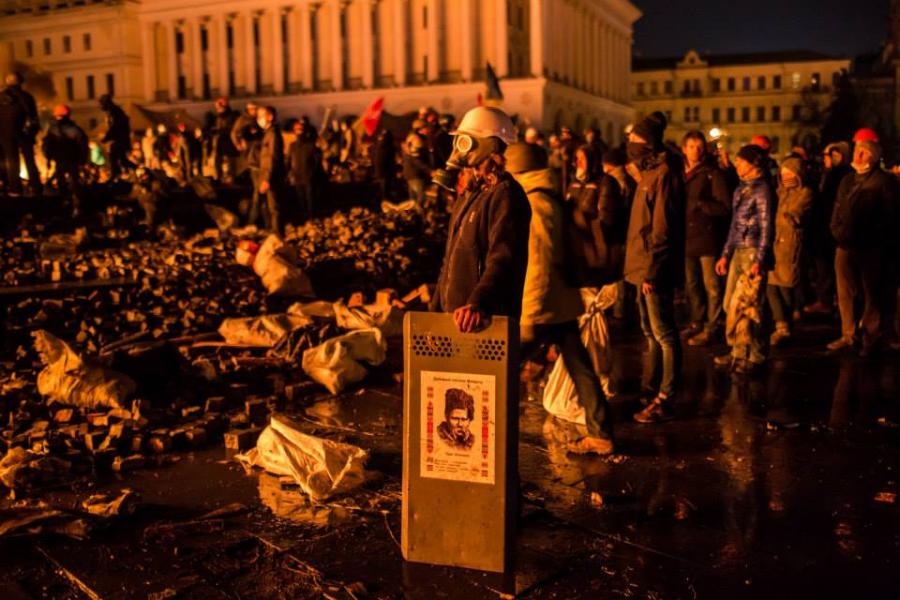
Anti-governmental protest frontlines in Kyiv 19.02.2014.
‘Winter On Fire’ reinforces the narrativity and the chronological order of the events. This way of documentary construction has logical reasoning by the way it resists the misinformation and aims for viewers to “witness Ukrainian revolution with your own eyes” (Afineevsky, 2015). The documentary is oriented towards the ‘outside’ viewer, unfamiliar with the country’s political context. By keeping the film chronological, it takes a ‘truthful’ and credible perspective in what it broadcasts to the audience. Narrativity in the case of ‘Winter On Fire’ has a pragmatic truth-telling function.
Cinematic Realism
The way the documentary is filmed contains a few key elements. Firstly,‘Winter On Fire’ uses different types of content as a way to tell the story. Some of the documentary’s elements contain animations of maps of the city, clarifications of locations and names, inserted media footage, and historical references. The film does not contain voice-overs, but uses subtitles for reaching a 'first-hand' approach. In this , the work presents material from both a close perspective and a more distanced view. The audience can follow the events from afar as a part of a whole. Further the audience can listen to the individual stories in the interviews and explore the revolution with the protesters on the streets of Kyiv.
Secodly, a significant part of ‘Winter On Fire’ consists of the shots filmed by the directing team of the documentary. Among those are the interviews with the activists and footage from within the protesting streets. The documentary’s footage heavily consists of the mobile phones’ amateur shoots from both the battlefields and content available online posted by participants and bystanders of the protests.
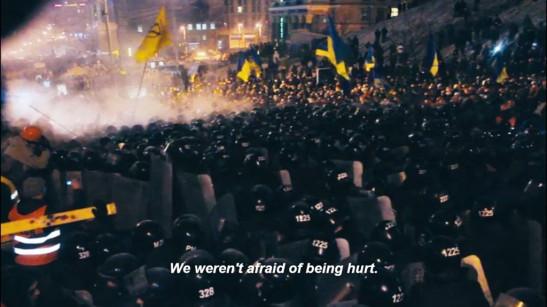
One of the activists sharing his thoughts and the footage from the protests in Kyiv.
Finally, all of the elements contribute to the documentary taking on a more ‘human perspective’ which is important in representing political discourse and resisting propaganda. Such representation has its beginning from the style of Cinematic Realism. The way films depict reality has always led to experiments with “realist modes as a means of exposing social injustice and fostering revolution” (Wilson, 2014).
‘Winter On Fire’ aims at showing injustice and social problems by taking a realistic perspective and representing facts as accurately as possible. The production team spent sufficient time in the field. In this way, they managed to collect footage and to gain expert knowledge on the topic to claim ‘realism’ (Van der Beek, 2020). The other way to declare a realistic perspective is by mixing non-fiction journalism (Van der Beek, 2020) in the interviews with creating a certain chronological plot reinforced by on the spot footage.
The documentary is adapted to the format which is easy to consume for the wider public reinforcing television as “the new journalism” (Wilson, 2014). This is done by the platform choice, the timely ordered display of events, and the way some participants are displayed as relatable to the viewer. For example, throughout the film, the audience follows a homeless underaged boy who, in line with the older peers, tries to contribute to the protests.
The above-mentioned claims of representing reality are inspired by cinematic realism and are used widely in the films reflecting social injustice, political struggles, protests, and other related events. ‘Winter On Fire’ is a documentary that uses the realistic tradition to appear authentic and credible reflecting the discourse of the Ukrainian revolution and anti-oppression politics. ‘Winter On Fire’ also builds on the tradition of cinematic realism to “examine the ways in which a population can be exposed to social issues in their totality” and stands as an expansion of this model (Wilson, 2014).
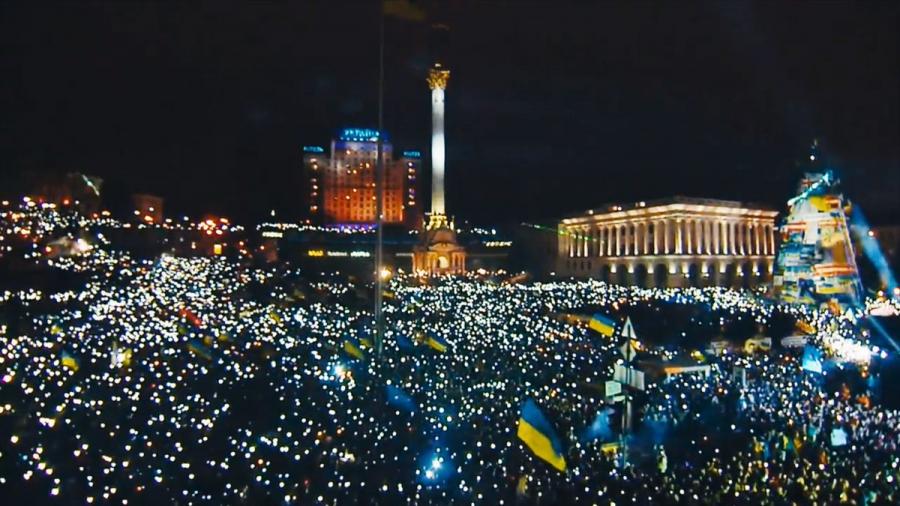
Protests in Kyiv as shown in 'Winter On Fire'.
The documentary uses such methods as shooting in real locations, non-professional participants, and simple stories to uncover the depths of the civil movement in Kyiv. The focus of ‘Winter On Fire’ is on people, the dynamic of the protest, and the ordinary ‘human’ perspective of the revolution. The close distance the documentary fosters nearly anthropological or ethnographic fascination with the Ukrainian revolution events (Potter & Marshall, 2009, in Wilson, 2014). The documentary uncovers the problematization of representing civil unrest for they are usually showed as a chaotic collective action. However, they consist of millions of individuals with their unique contributions and perspectives, aligned as a part of a whole. ‘Winter On Fire’ makes audiences “consider new ways in which marginalized groups may be represented in a world” (Wilson, 2014) by trying to show a ‘credible’ first-hand perspective on the revolution.
The film does not romanticize the events in Kyiv but displays the harsh circumstances the protesters face. ‘Winter On Fire’ showsfootage of the protesters living conditions , the burned and destroyed buildings and streets, frontline evidence that displays police brutality, and coffins of those who died in the fights with special forces. By doing so, the film takes viewers out of their comfort zone showing the uncomfortable ‘truthful’ side of living. In this way, ‘Winter On Fire’ resists the process of media converting of “the suffering lived experience of others into a commodity for safe middle-class consumption” (Wilson, 2014). The realistic perspective of the documentary aims to make more understandable and relatable for audiences unfamiliar with these events.
Observational and Participatory Documentary modes
‘Winter On Fire’ combines two modes of documentary filmmaking. The first is,'observation.'This is as if the director was ‘a fly on the wall’ (Nichols, 2010). The film uses observation in the way it "emphasizes a direct engagement with the everyday life of subjects as observed by an unobtrusive camera" (Nichols, 2010). This observation mode is provided by the technical advances with which the filmmaker can record footage relatively unnoticed using both portable cameras and mobile devices. The action in ‘Winter On Fire’ mostly goes without any interference from the directors. The documentary captures the events in naturally occurred settings without influencing the observed. 'Winter On Fire' often picks up "a journalistic tone of apparent neutrality with a strongly observational style" (Nichols, 2010). The directors do not provide any verbal commentary or argumentation in their filming of the protests.
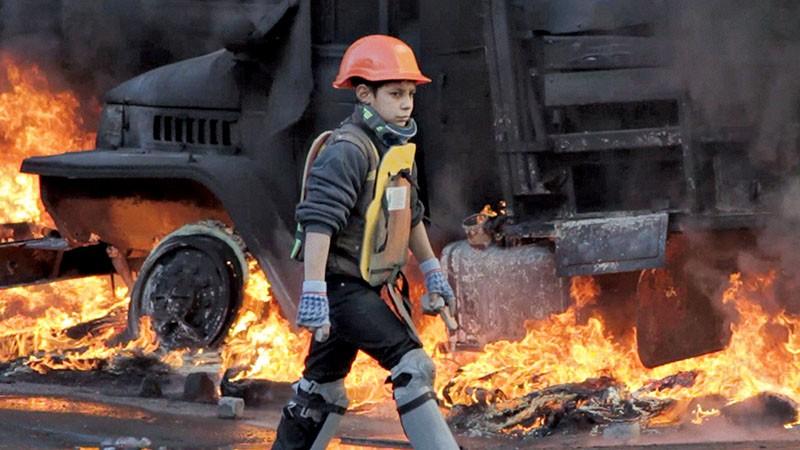
The documentary uninterruptedly captures the underaged boy participating in the protests.
The aim of such a documentary mode selection is to capture the events as direct and as truthful as possible. The directors of ‘Winter On Fire’ tried to highlight the truthfulness of the documentary by spending time in the frontlines among the protests to capture the flow of the revolution. The film captures the crisis and “social actors [who] engage with each other, ignoring the filmmakers” (Nichols, 2010). It is up to the viewer to connect the dots and to make sense of the scenes displayed in the documentary.
The ‘raw’ footage from the frontlines shown in ‘Winter On Fire’ is primarily observational. The displayed scenes do not feature the intervention of the filmmakers. They are filmed chronologically and don’t manipulate the events, but aim at capturing them as they occur. ‘Winter On Fire’ articulates diegetic sounds when it displays the non-scripted realities of the protesters.
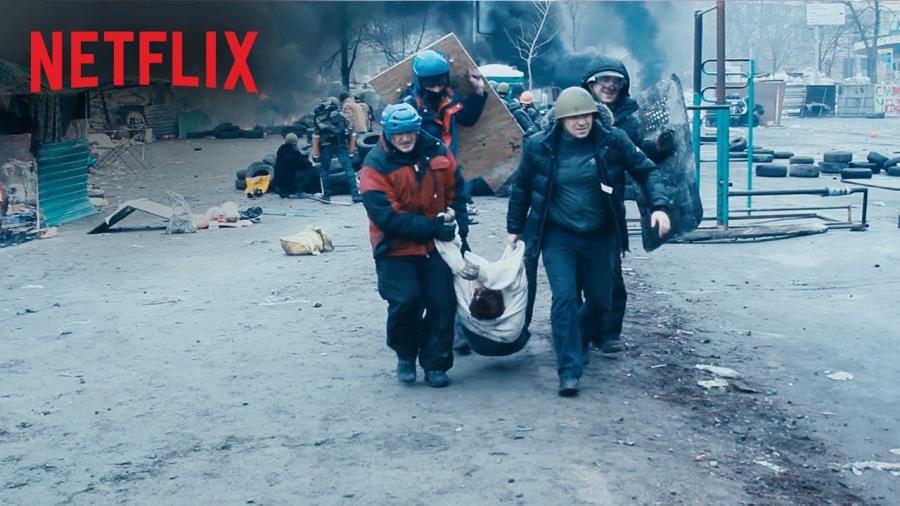
'Winter On Fire' shows the cruel and deadly battles from the protest's frontlines.
The second mode of documentary filmmaking ‘Winter On Fire’ features is a participatory mode. The movie contains numerous interviews with the witnesses and participants of protests, emphasizing “interaction between filmmaker and subject” (Nichols, 2010). In conversations with the activists, the presence of the directors is evident. Situation changes by the filmmakers posing questions on the events of the Ukrainian revolution. The parts of the documentary with the interviews in them take a confrontational approach. The expert footage makes obvious the filmmakers’ role in the scene-setting and production process. Besides using interviews and obvious interaction with the subjects, the participatory mode is "often coupled with archival footage to examine historical issues" (Nichols, 2010) which is used in 'Winter On Fire' to clarify the political context.
The combination of the two modes reinforces the political narrative of the documentary. ‘Winter On Fire’ combines truthful elements of events’ ‘raw’ footage and the expert opinions to make the audience come up with connections and conclusions on the public sphere discourse in Ukraine in 2013-2014. The participatory parts reinforce the truthful chronological order of the main narrative. While raw footage serves as the evidence to the events in Kyiv, the expert interviews aim at reinforcing its truths.
Reality Effects
The detailed description of events carries an aesthetic purpose, following the centuries-long tradition of Western culture that started with antiquity (Barthes, 1986). ‘Reality’ in the film is not necessarily a cause, as might seem from the first sight, but a strategy. The reality effect is produced as a result of forming the aesthetic based on the “unavowed verisimilitude” (Barthes, 1986) which means that the cultural product can reinforce storytelling by using the detailed description of events. ‘Winter On Fire’ chooses "‘shaky’ footage, out of focus low image quality, bad lighting, partial editing, addressing the camera, and obscure vision" (Van de Ven, 2020) as the contributors to its way of storytelling.
The documentary displays many features of day-to-day revolutionary life. The smiles of children, the tears of elderly people, the ordinary life of the protest camp are barely noticeable but significant details contributing to the film's aesthetics. 'Winter On Fire' could build on the parallel with Flaubert's 'Madame Bovary' as described by Barthes (1986). The traits of some characters, the author claims, do not contribute to the development of the storyline and are "irrelevant to the narrative structure" (Barthes, 1986). However, such details add to the artistic and literary tradition of "'realistic' imperatives" (Barthes, 1986).
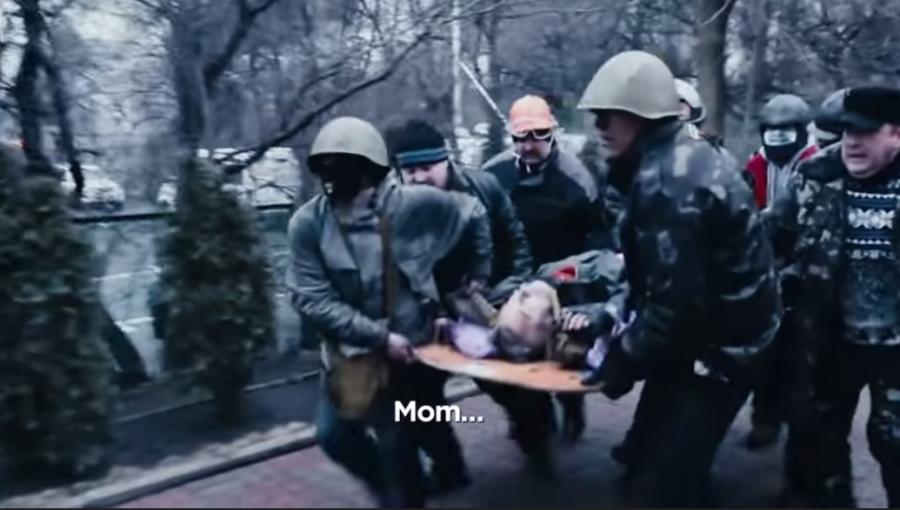
The choice of the documentary to include certain scenes because of their significance and not necessarily the quality of the imagery.
Inserting the ‘raw’ mobile phone footage into the film, ‘Winter On Fire’ uses this artistic move as a strategy to appear more credible, trustworthy, and ‘real’ to the viewers. Seeing almost always means believing (Van de Ven, 2020). Nichols (2010) states that through "the capacity of audio and visual recording devices to record situations and events with great fidelity, we see in documentaries people, places, and things that we might also see for ourselves, outside the cinema" which increases the credibility of the cultural product. The audience is led by the belief "we see what was there before the camera; it must be real (it really existed or happened)" (Nichols, 2010).
The rapid digitalization opens up tensions between what is truth and fiction ‘de-ontologizing’ the indexical image. The audience is encouraged to trust the facts represented in the film by the different perspectives it shows. ‘Winter On Fire’ chooses to include mobile phone footage for it to serve as evidence of what has happened in Kyiv during the revolution, making it a part of the film’s style.
Photographic media are indexical and they link the audience to certain conclusions of which the reality feeling is an effect (Van de Ven, 2020). The chosen strategy of using first-hand experience footage contributes to the film’s storytelling but also displays artistic vision and investment into the realistic filmmaking tradition.
Ethos, pathos, and logos: The role of truth and fiction in politics
Aristotle in his 'Rhetoric' divided artistic proofs into the three parts: ethos, pathos, and logos (Nichols, 2010). ‘Winter On Fire’ uses ethos by interacting with witnesses to appear credible. The documentary reinforces pathos by "appealing to the audiences' [and by] putting the audience in the right mood" (Nichols, 2010). Logos in the film is used by applying "real or apparent reasoning" (Nichols, 2010) in the clear and logical way it describes the case. The three artistic proofs make the film complete and help in building an engaging, emotional, and chronological narrative that brings a political message across.
‘Winter On Fire’ has a few key functions it fulfills. The documentary aims at representing the political events in a truthful way as seen by the protesters. The film is a rich information source both for those who are abroad and the locals. Even the staged or fictional elements, such as interviews, or map visualizations are used to reinforce the political discourse of the documentary.
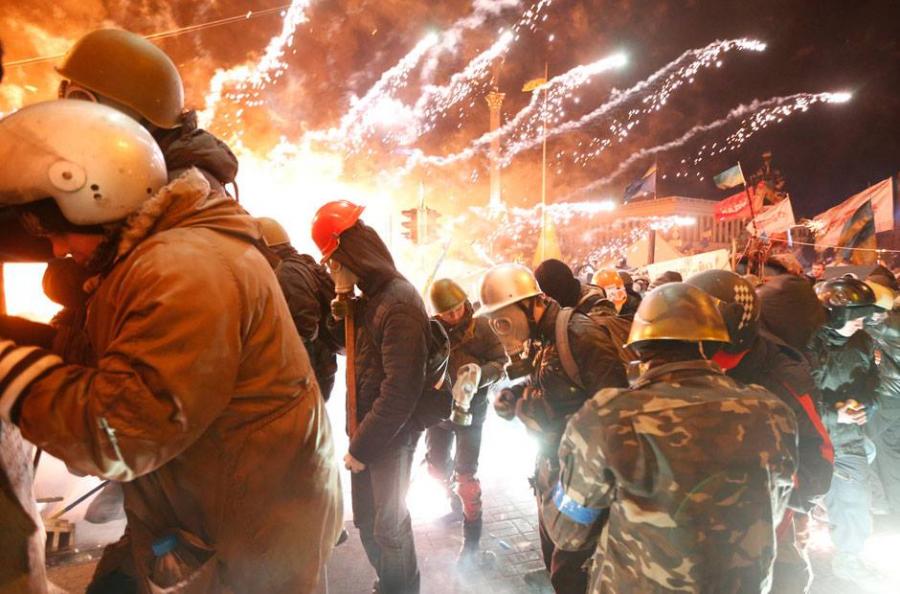
Protesters on the night of 18.02.2014 in Kyiv, Ukraine.
The film also serves as a call for action and a way to inspire others to act upon injustice and a corrupt system. ‘Winter On Fire’ was influential in Hong Kong’s Summer of Unrest. The citizens comparedthe two movements in their struggle for democracy (Leung, 2019). The film can be taken as a step-by-step guide on how to fight the corrupt system of a country.
The vivid display of Ukraine’s struggles in ‘Winter On Fire’ has a moral function. The film can be analyzed from an ethical perspective. The documentary shows the consequences the nation can face if neglected by the powerful elites. The documentary displays unity, mutual support, and solidarity of the citizens towards each other fighting for the idea of improving their country.
To achieve all these goals, ‘Winter On Fire’ aims at building a chronological narrative that mixes truthful elements with staged, or fictional ones. The documentary balances between closeness and distance and tries to take an objective approach to present different perspectives to the viewer.
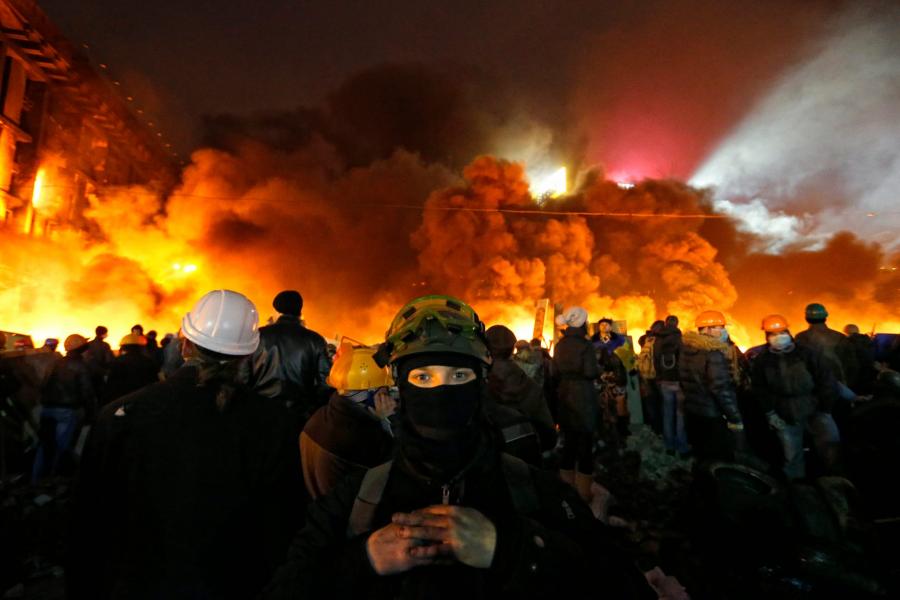
Protestor Maksym in 'The Night of Apocalypse' in Kyiv, Ukraine.
As a result of mixed styles, modes, and perspectives, ‘Winter On Fire’ appears a credible source of information on the Ukrainian revolution. Being a witness of the events, I could conclude that the filmmakers have tried to represent the issue from various perspectives and that they have done it sufficiently and truthfully.
However, what one has to keep in mind when analyzing political documentaries is that facts are easy to manipulate in contemporary filmmaking. The different methods of representing the truth in cinematography can be applied to mislead the audience. Showing multiple perspectives, maps, historical context, and interviews can be a part of fiction to distribute fake news and misinformation.
References
Albrecht, E. (2019). Evolution of Russia's informational warfare in Ukraine: Interview with Olga Yurkova of Stopfake. DW.
Barthes, R. (1986). The Rustle of Language. Farrar, Straus and Giroux, Inc.
Leung, H. (2019). Hong Kong's Summer of Unrest Has Been Drawing Inspiration From Ukraine's Winter on Fire. Time.
Nichols, B. (2010). Introduction to Documentary, Second Edition. Indiana University Press.
Potter, T., Marshall, C. W. (2009). ‘I am the American Dream’ Modern Urban Tragedy and the Borders of Fiction. In The Wire: Urban Decay and American Television. Continuum. New York.
Strawson, G. (2004). Against Narrativity. Ratio.
Van de Ven, I. (2020). The Truth of Fiction: Introduction. Tilburg University. [PowerPoint Presentation].
Van der Beek, S. (2020). The Truth of Fiction: Reality in fictional TV series. Tilburg University. [PowerPoint Presentation].
Wilson, G. (2014). The Bigger the Lie, the More They Believe”: Cinematic Realism and the Anxiety of Representation in David Simon’s The Wire. Texas A&M University.
Winter on Fire: Ukraine’s Fight for Freedom. (2015). Netflix.